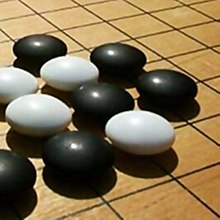Go software
| Part of a series on |
| Go |
|---|
 |
| Game specifics |
|
| History and culture |
| Players and organizations |
| Computers and mathematics |
There is an abundance of go software available to support players of the game of Go. This includes software programs that play Go themselves, programs that can be used to view and/or edit game records and diagrams, programs that allow the user to search for patterns in the games of strong players and programs that allow users to play against each other over the Internet.
Go playing programs
Although Go playing programs are no stronger than the average amateur player, they can still provide an interesting opponent to many players, especially when the handicapping system is used. Also, some of the newer programs can play a reasonably strong game on the reduced 9x9 boardsize. A more in depth look into Go playing programs and the research behind them can be found in the article on computer go.
Recording
There are several file formats used to store game records, the most popular of which is the Smart Game Format (SGF). Programs used for editing game records allow the user to record not just the moves, but also variations, commentary and further information on the game[1]
Databases
Electronic databases can be used to study life and death situations, joseki, fuseki and games by a particular player. Programs are available give players pattern searching options, which allows a player to research positions by searching for high level games in which similar situations occur. Such software will generally list common follow up moves that have been played by professionals, and give statistics on win/loss ratio in opening situations.
Internet servers and clients
Many Internet-based Go servers allow access to competition with players all over the world[2]. Such servers also allow easy access to professional teaching, with both teaching games and interactive game review being possible[3].
The first Go server that started operating is the Internet Go Server (IGS), which began service in 1992[4] and is still active today. Several other servers, all with the same basic server-client architecture, followed[5]. Such servers required players to download a client program, and many such programs were therefore developed for a wide range of platforms[5]. Around 2000, Kiseido publishing started the Kiseido Go Server (KGS), which allowed players to play without downloading a client by utilizing a Java applet in the browser. This server quickly became popular and still is today. IGS and KGS are currently (2007) the most popular servers for the English speaking audience[6]
Notes
- ^ Lists of such programs may be found at Sensei's Library and GoBase
- ^ Lists of Go servers are kept at Sensei's Library and the AGA website.
- ^ The British GO Association provides a list of teaching services
- ^ Jim Z. Yu A Brief History of IGS, the Early Years - 1992 & 1993 Retrieved on 2007-12-11
- ^ a b British Go Association. "Go Servers - A Short History". Retrieved 2007-12-11.
- ^ British Go Association. "Internet Go". Retrieved 2007-12-11.
See also
External links
- List of Go playing programs on Sensei's Library.
- List of game record editing programs on Sensei's Library.
- List of Database programs on Sensei's Library.
- List of game record editing programs on GoBase.
- List of internet Go servers on Sensei's Library.
- List of internet Go servers on the AGA website.
- List of teaching services on the BGA website.
- Free Go Software
- GoKnot, a Windows solution open for developing
- Alejo's Tenuki Video-reviews and analysis on database analysis programs.
- GoNote Browser-based go boards in a number of different sizes.
User Interfaces
These programs provide graphical interfaces on a variety of platforms, performing various combinations of the services listed above.
- CGoban - Linux / Unix
- Drago - Windows
- gGo - Java based
- glGo - Linux / Windows; a prototype for a 3D goban display
- Goban - Mac OS X
- GoGui - Java based
- Jago - Java based
- qGo - Linux / Windows / Mac OS X ; also a IGS client
- Quarry - Linux, GTK+-based
- Ruby Go - Linux, Unix, Windows, Tk-based
- Stonebase - Windows; a FREE multiple-function software designed for supporting GO study, including a 170MB database with Go games / books.
